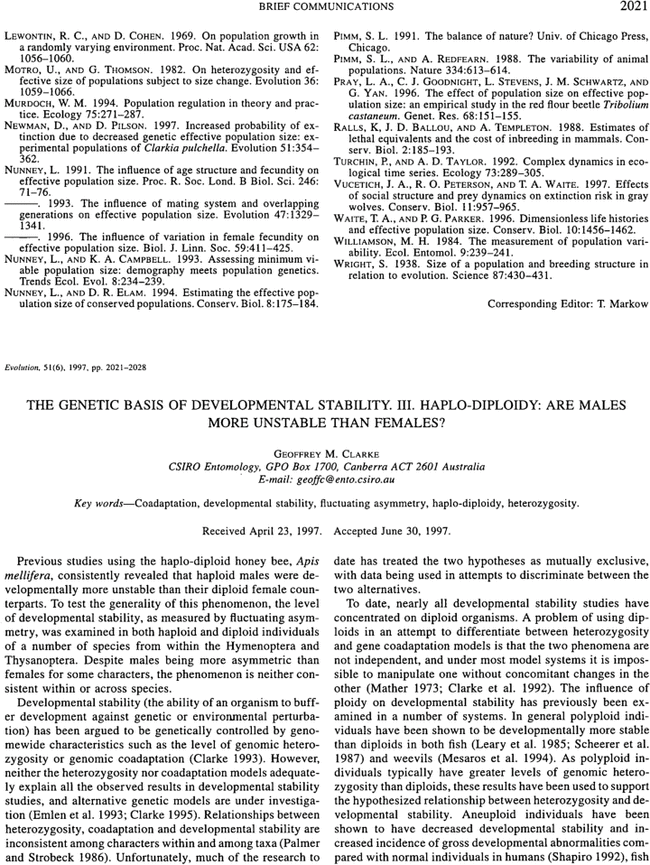Brief Communication
Free Access
THE GENETIC BASIS OF DEVELOPMENTAL STABILITY. III. HAPLO-DIPLOIDY: ARE MALES MORE UNSTABLE THAN FEMALES?
Geoffrey M. Clarke,
Geoffrey M. Clarke
CSIRO Entomology, GPO Box 1700, Canberra, ACT, 2601 Australia
Search for more papers by this authorGeoffrey M. Clarke,
Geoffrey M. Clarke
CSIRO Entomology, GPO Box 1700, Canberra, ACT, 2601 Australia
Search for more papers by this authorCorresponding Editor: T. Markow

Literature Cited
- Akimov, I. A., L. M. Zaloznaya, V. M. Efimov, and Y. K. Galaktionov. 1991. Seasonal and geographical variation of morphological characters of Varroa jacobsoni (Parasitiformes: Varrodidae): variation of mean values, standard deviations, and coefficients of fluctuating asymmetry. Entomol. Rev. 70: 106–117.
- Batterham, P., A. G. Davies, A. Y. Game, and J. A. McKenzie. 1996. Asymmetry—where evolutionary and developmental genetics meet. Bioessays 18: 841–845.
- Beardmore, J. A. 1960. Developmental stability in constant and fluctuating temperatures. Heredity 14: 411–422.
10.1038/hdy.1960.38 Google Scholar
- Brückner, D. 1976. The influence of genetic variability on wing symmetry in honeybees (Apis mellifera). Evolution 30: 100–108.
- Clarke, G. M. 1993. The genetic basis of developmental stability. I. Relationships between stability, heterozygosity and genomic coadaptation. Genetica 89: 15–23.
- Clarke, G. M. 1995. The genetic basis of developmental stability. II. Asymmetry of extreme phenotypes revisited. Am. Nat. 146: 708–725.
- Clarke, G. M., and J. A. McKenzie. 1987. Developmental stability of insecticide resistant phenotypes in blowfly; a result of canalizing natural selection. Nature (Lond.) 325: 345–346.
- Clarke, G. M., and B. P. Oldroyd. 1996. The genetic basis of developmental stability in Apis mellifera. II. Relationships between character size, asymmetry and single-locus heterozygosity. Genetica 97: 211–224.
- Clarke, G. M., G. W. Brand, and M. J. Whitten. 1986. Fluctuating asymmetry: A technique for measuring developmental stress caused by inbreeding. Aust. J. Biol. Sci. 39: 145–153.
- Clarke, G. M., B. P. Oldroyd, and P. Hunt. 1992. The genetic basis of developmental stability in Apis mellifera: Heterozygosity versus genic balance. Evolution 46: 753–762.
- Crespi B. J., and B. A. Vanderkist. 1997. Fluctuating asymmetry in vestigial and functional traits of a haplodiploid insect. Heredity. (In press).
- Emlen, J. M., D. C. Freeman, and J. H. Graham. 1993. Nonlinear growth dynamics and the origin of fluctuating asymmetry. Genetica 89: 77–96.
- Hagen, D. W. 1973. Inheritance of numbers of lateral plates and gillrakers in Gasterosteus aculeatus. Heredity 30: 303–312.
- Jokela, P., and P. Portin. 1991. Effect of extra Y chromosome on number and fluctuating asymmetry of sternopleural bristles in Drosophila melanogaster. Hereditas 114: 177–187.
- Keller, L., and L. Passera. 1993. Incest avoidance, fluctuating asymmetry, and the consequences of inbreeding in Iridomyrmex humilis, an ant with multiple queen colonies. Behav. Ecol. Sociobiol. 33: 191–199.
- Krysanov, E. Y. 1992. Aneuploidy in postnatal development of fishes. Acta Zool. Fenn. 191: 177–182.
- Leary, R. F., F. W. Allendorf, and K. L. Knudsen. 1983. Developmental stability and enzyme heterozygosity in rainbow trout. Nature 301: 71–72.
- Leary, R. F., F. W. Allendorf, K. L. Knudsen, and G. H. Thorgaard. 1985. Heterozygosity and developmental stability in gynogenetic diploid and triploid rainbow trout. Heredity 54: 219–225.
- Mather, K. 1953. Genetical control of stability in development. Heredity 7: 297–336.
- Mather, K. 1973. Genetical structure of populations. Chapman and Hall, London.
- Mesaros, G., B. Tucic, and N. Tucic. 1994. Directional and fluctuating asymmetry in sexual and asexual Otiorhynchus alpicola populations. J. Zool. Syst. Evol. Res. 32: 211–219.
- Nevo E., A. Beiles, and R. Ben-Shlomo. 1984. The evolutionary significance of genetic diversity: ecological, demographic and life history correlates. Pp. 13–213 in G. S. Mani, ed. Evolutionary dynamics of genetic diversity. Lecture Notes in Biomathematics No. 53. Springer-Verlag, Berlin, Germany.
10.1007/978-3-642-51588-0_2 Google Scholar
- Palmer, A. R. 1994. Fluctuating asymmetry analyses: a primer. Pp. 335–364 in T. A. Markow, ed. Developmental instability: its origins and evolutionary implications. Kluwer, Dordrecht, The Netherlands.
10.1007/978-94-011-0830-0_26 Google Scholar
- Palmer, A. R., and C. Strobeck. 1986. Fluctuating asymmetry: measurement, analysis, patterns. Annu. Rev. Ecol. Syst. 17: 391–421.
- Pamilo, P., S.-L. Varvio-Aho, and A. Pekkarinen. 1978. Low enzyme variability in Hymenoptera as a consequence of haplodiploidy. Hereditas 88: 93–99.
- Pankakoski, E. 1985. Epigenetic asymmetry as an ecological indicator in muskrats. J. Mammal. 66: 52–57.
- Rahmel, U., and A. Ruf. 1994. A field method of assessing the impact of anthropogenic stress on natural animal populations: “Fluctuating asymmetry.” Nat. Schutz. Landsch. Pfl. Niedersachs. Beih. 69: 104–107.
- Reeve, E. C. R. 1960. Some genetic tests on asymmetry of sternopleural chaeta number in Drosophila. Genet. Res. Camb. 1: 151–172.
- Rice, W. R. 1989. Analyzing tables of statistical tests. Evolution 43: 223–225.
- Ross, K. G., and J. L. Robertson. 1990. Developmental stability, heterozygosity, and fitness in two introduced fire ants (Solenopsis invicta and S. richteri) and their hybrid. Heredity 64: 93–103.
- Scheerer, P. D., G. H. Thorgaard, and J. E. Seeb. 1987. Performance and developmental stability of triploid tiger trout (Brown trout FF X Brook trout MM). Trans. Am. Fish. Soc. 116: 92–97.
- Shapiro, B. L. 1992. Development of human autosomal aneuploid phenotypes (with an emphasis on Downs syndrome). Acta Zool. Fenn. 191: 97–105.
- Smith D. R., B. J. Crespi, and F. L. Bookstein. 1997. Fluctuating asymmetry in the honey bee, Apis mellifera—effects of ploidy and hybridization. J. Evol. Biol. 10: 551–574.
- Sokal R. R., and F. J. Rohlf. 1981. Biometry. Freeman, San Francisco, CA.
- SPSS I. 1996. SYSTAT 6.0 for windows: statistics. SPSS, Chicago.
- Van Valen, L. 1962. A study of fluctuating asymmetry. Evolution 16: 125–142.
10.2307/2406192 Google Scholar
- Zakharov, V. M. 1989. Future prospects for population phenogenetics. Sov. Sci. Rev. F Physiol. Gen. Biol. 4: 1–79.
- Zakharov, V. M. 1992. Population phenogenetics: analysis of developmental stability in natural populations. Acta Zool. Fenn. 191: 7–30.
- Zakharov, V. M. 1993. Appearance, fixation and stabilisation of environmentally induced phenotypic changes as a microevolutionary event. Genetica 89: 227–234.




